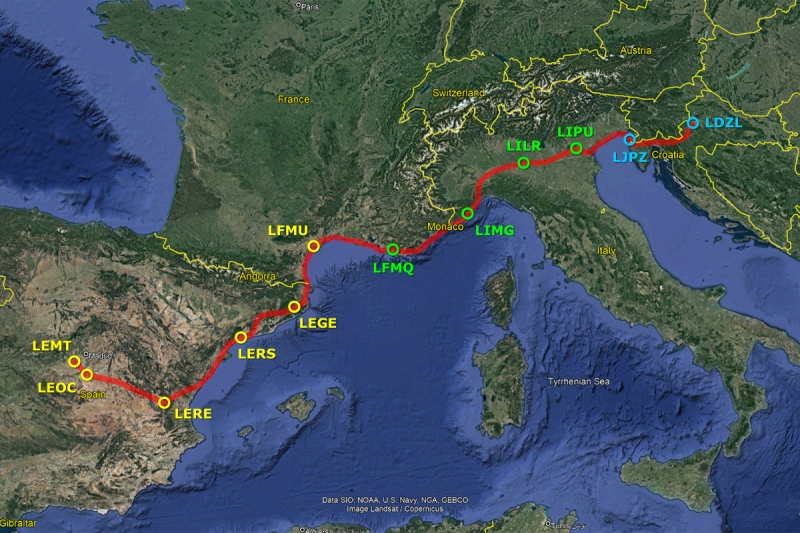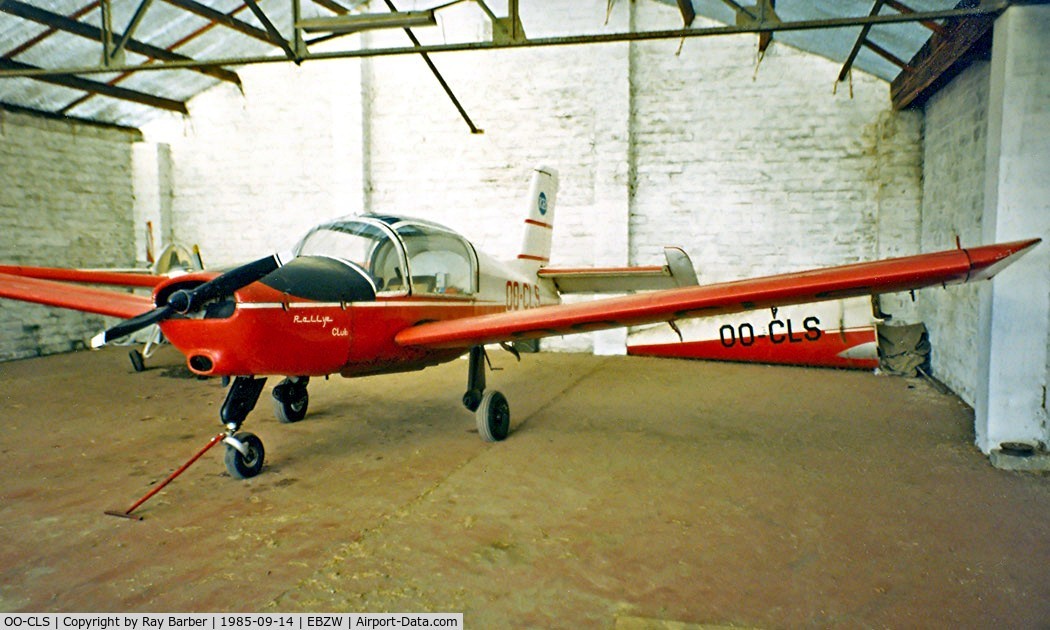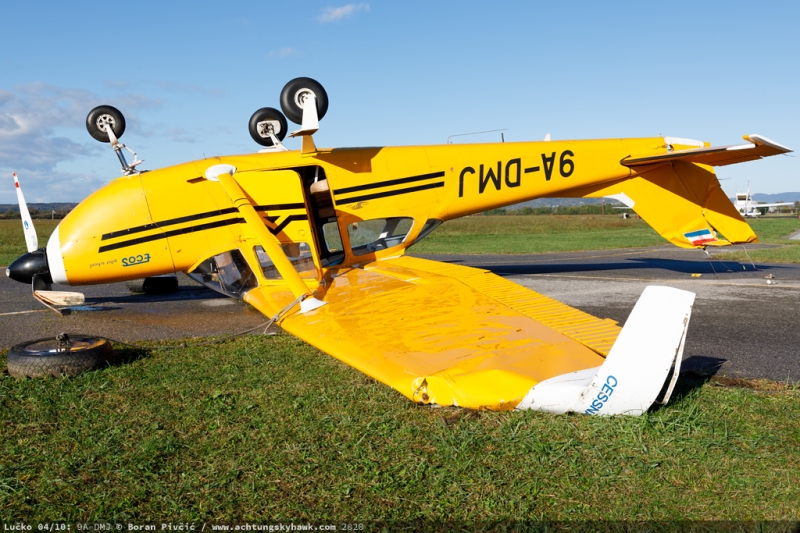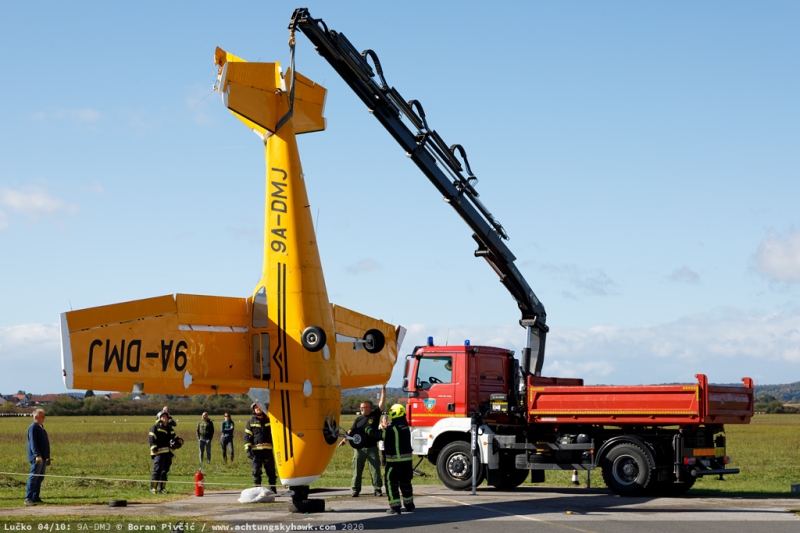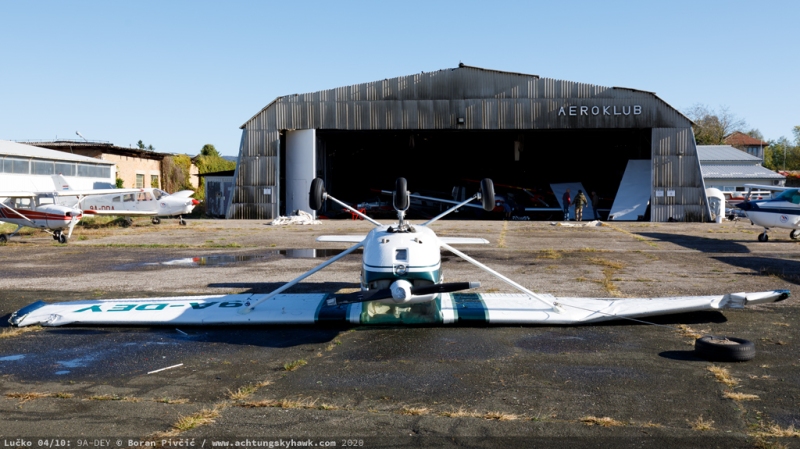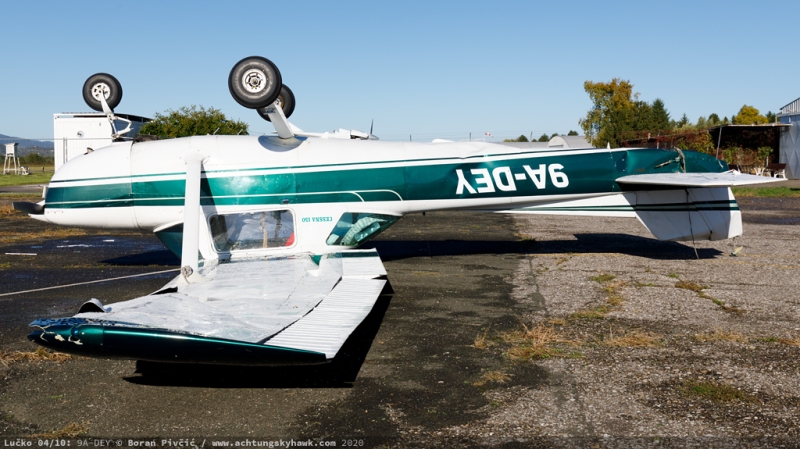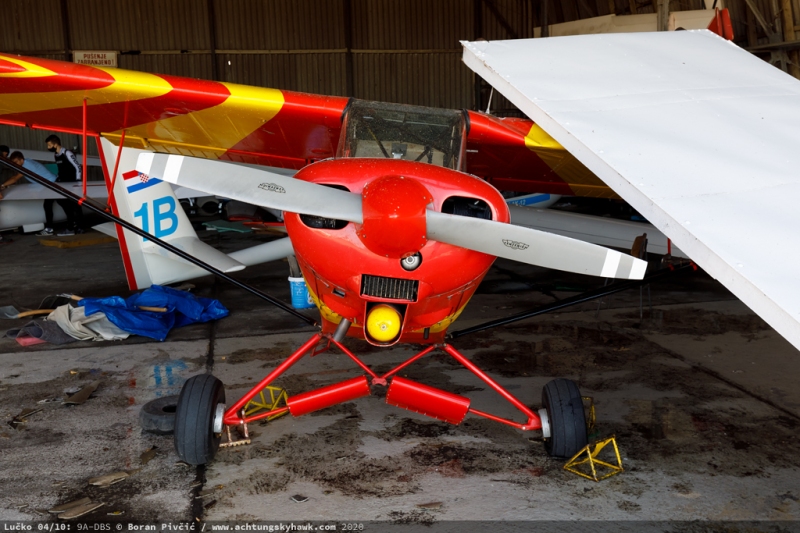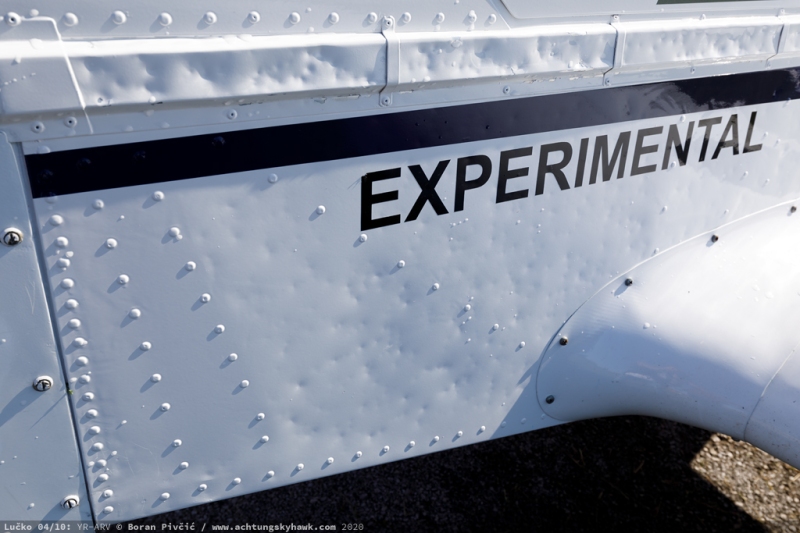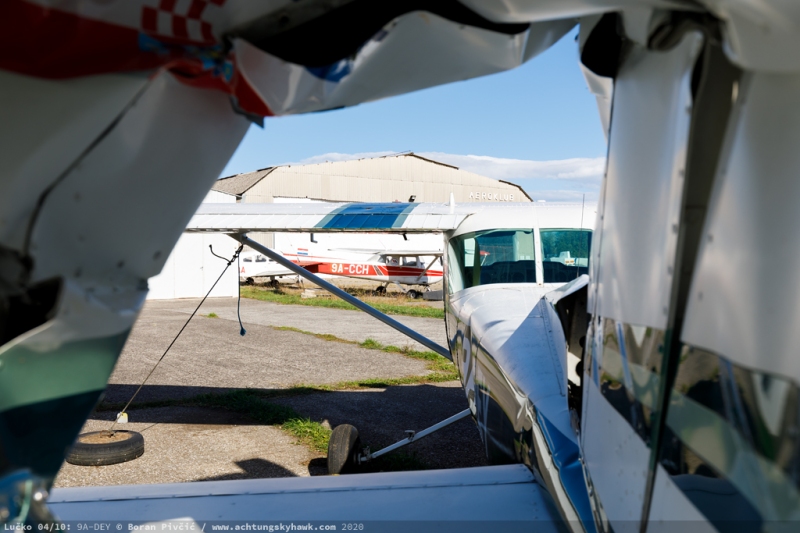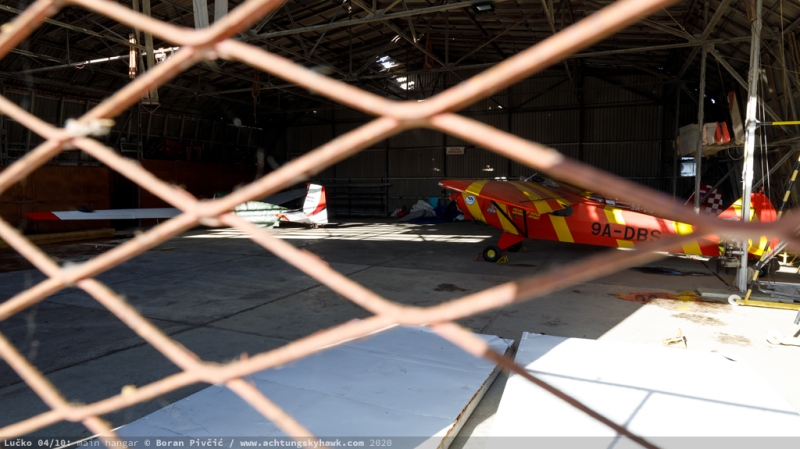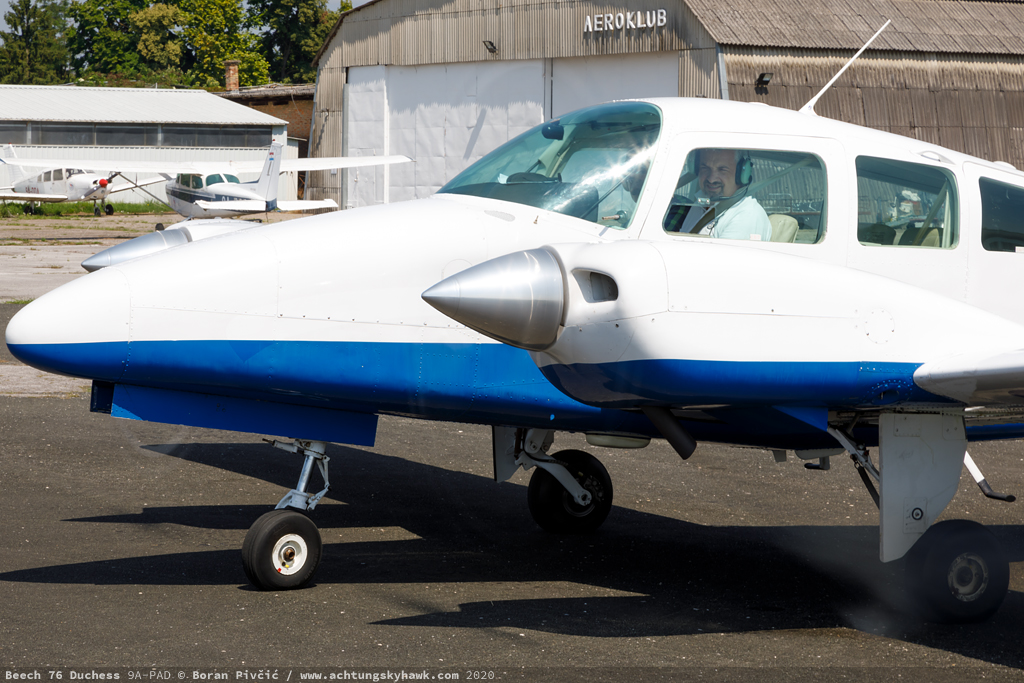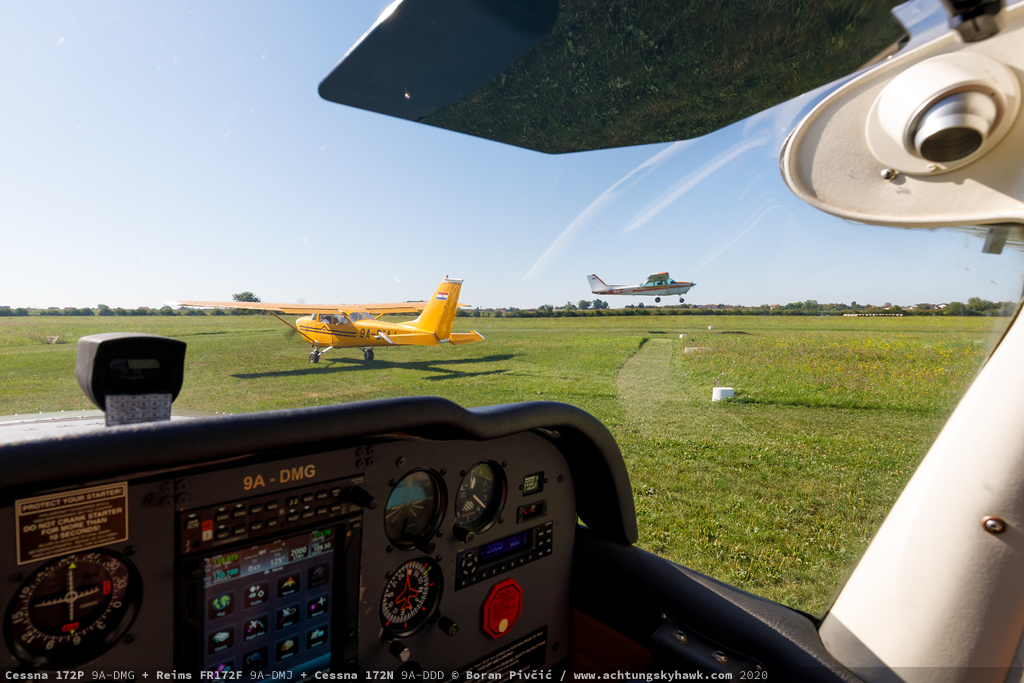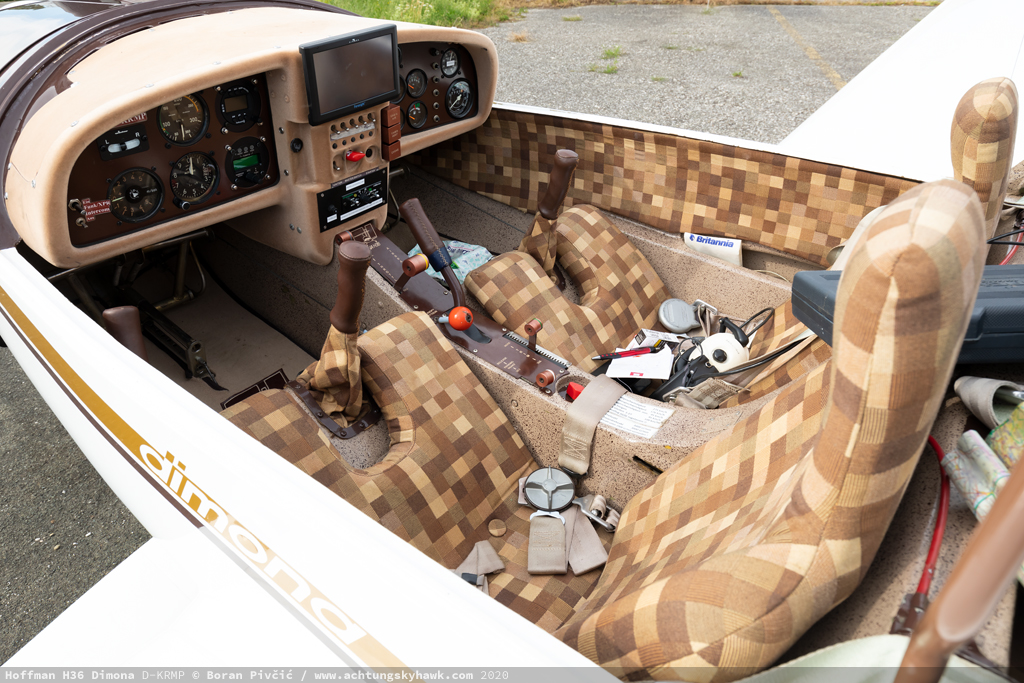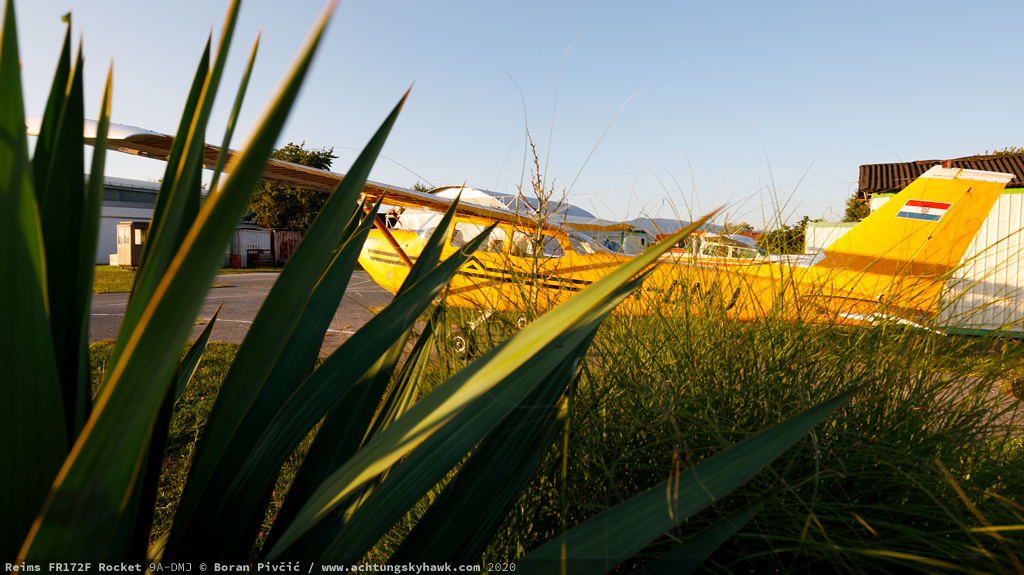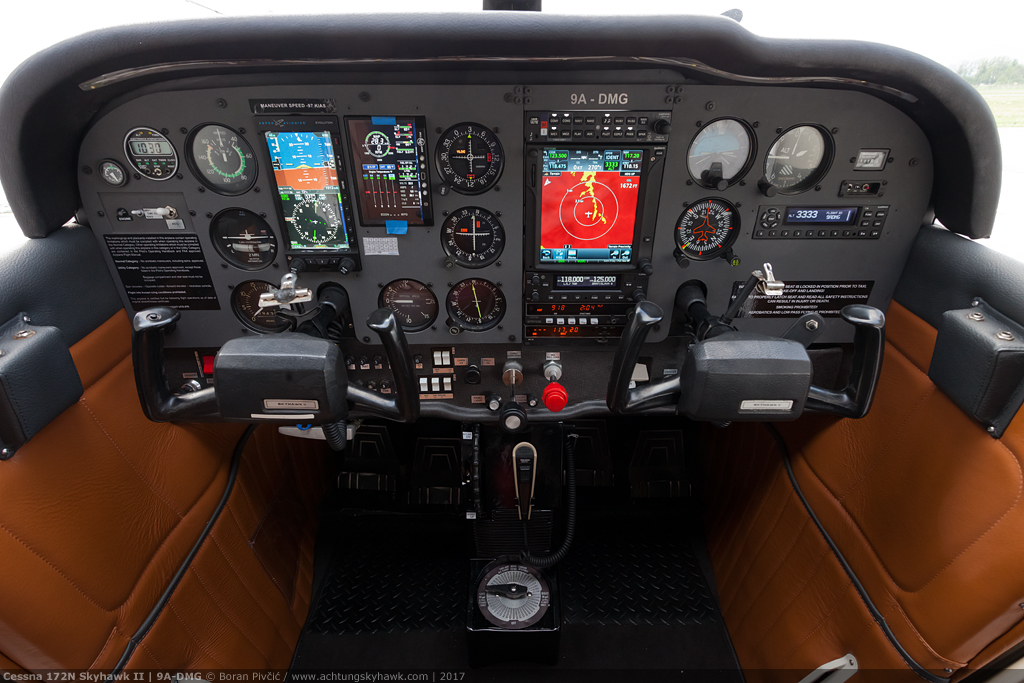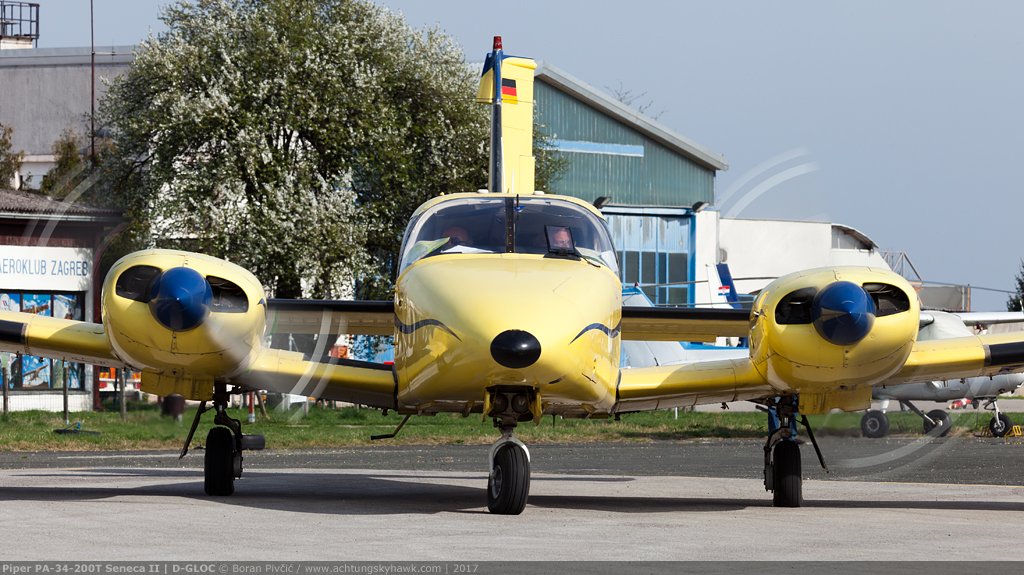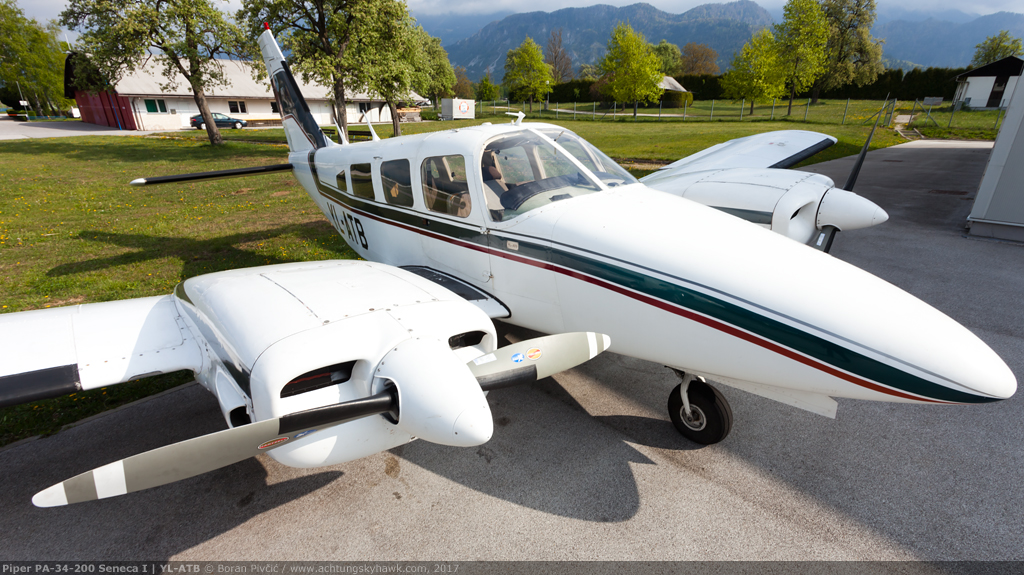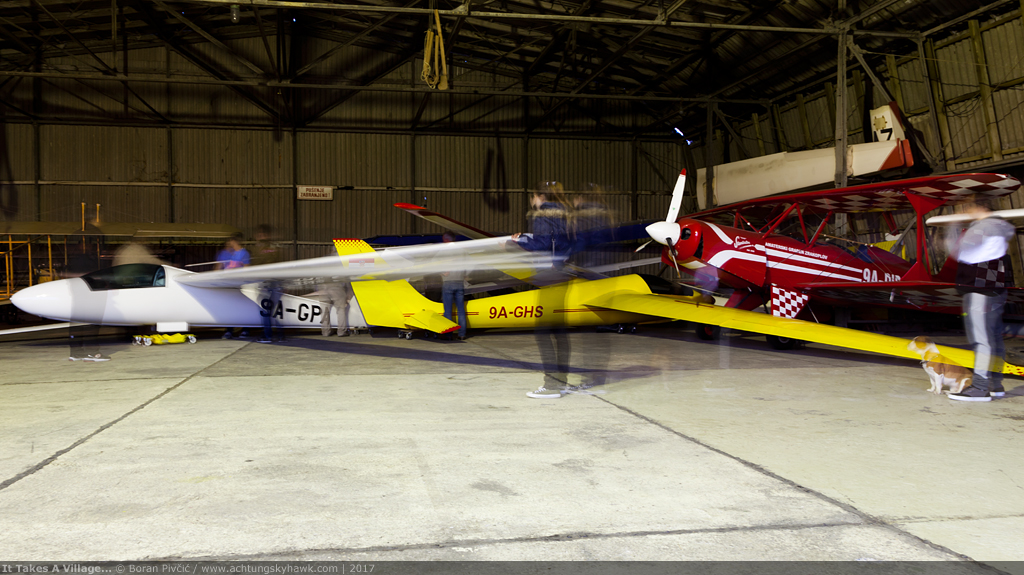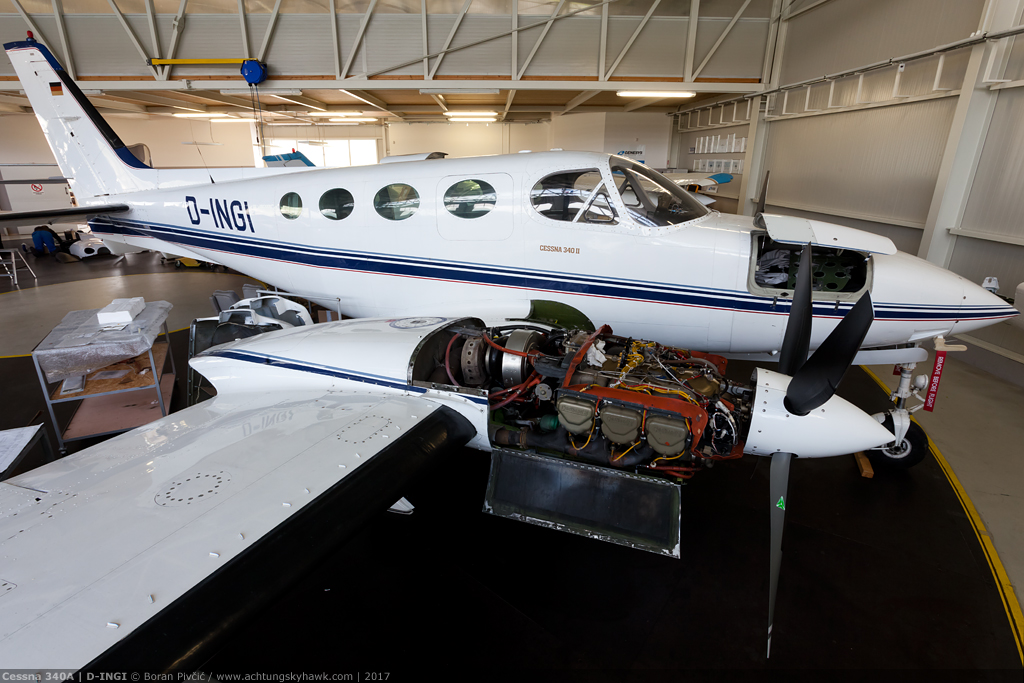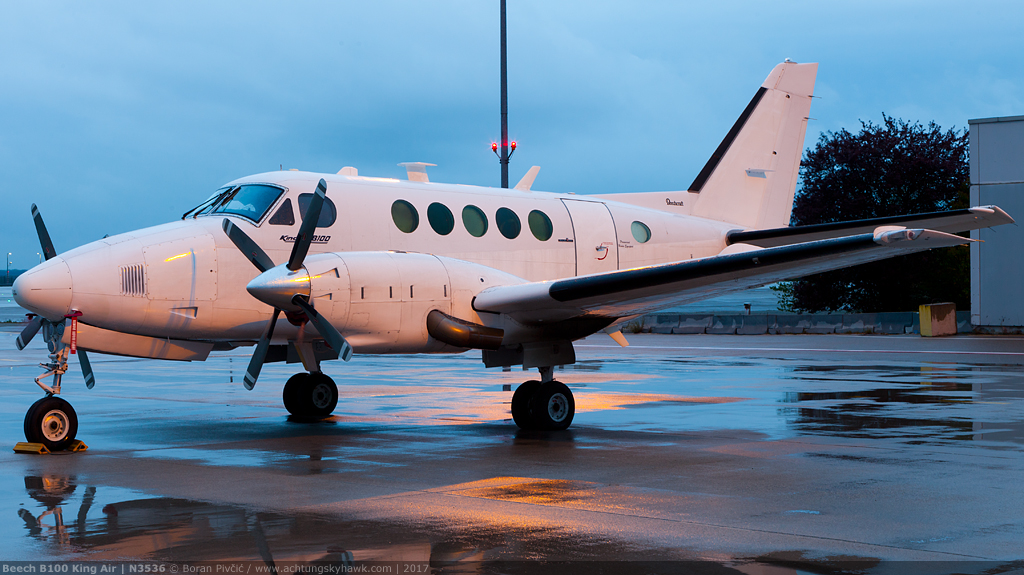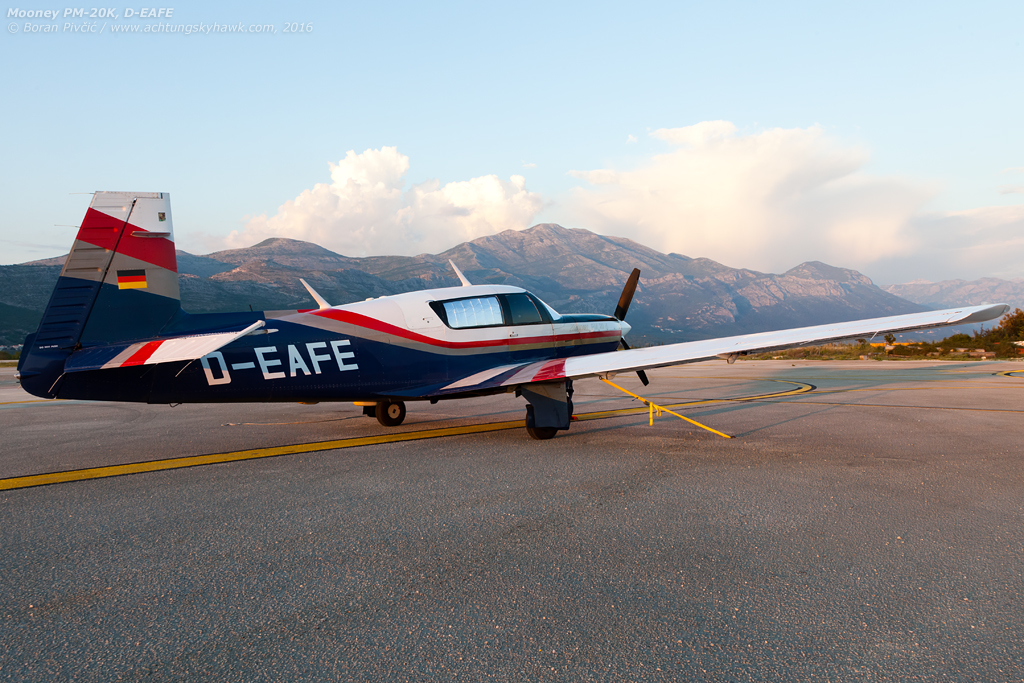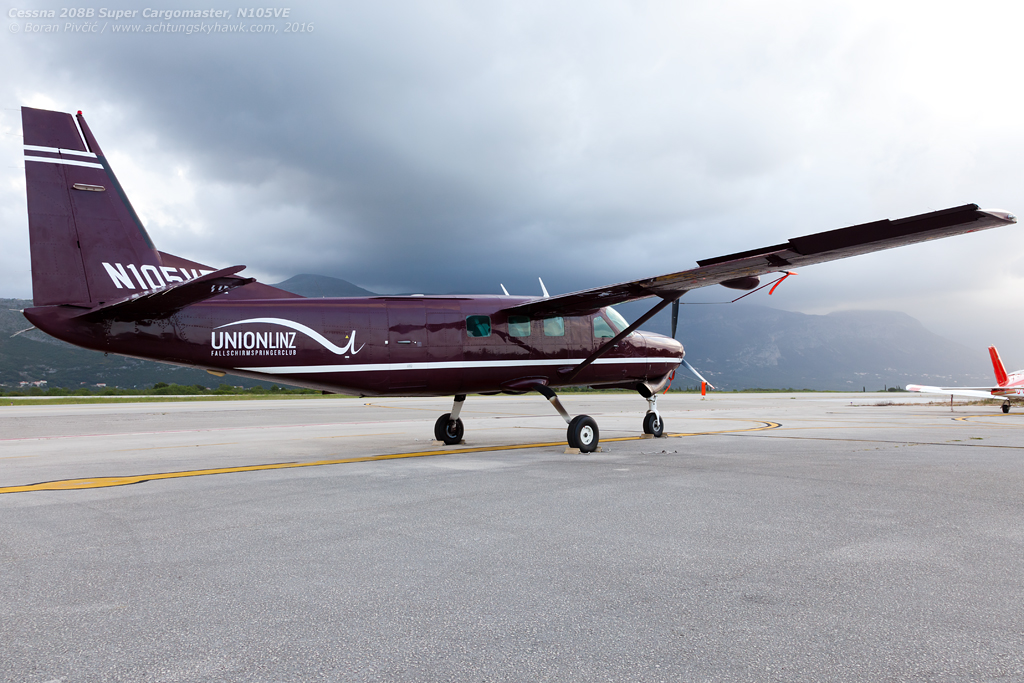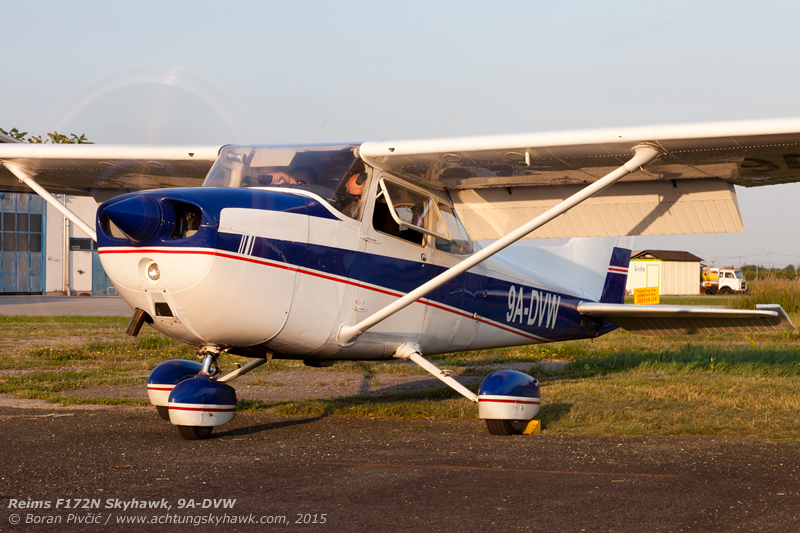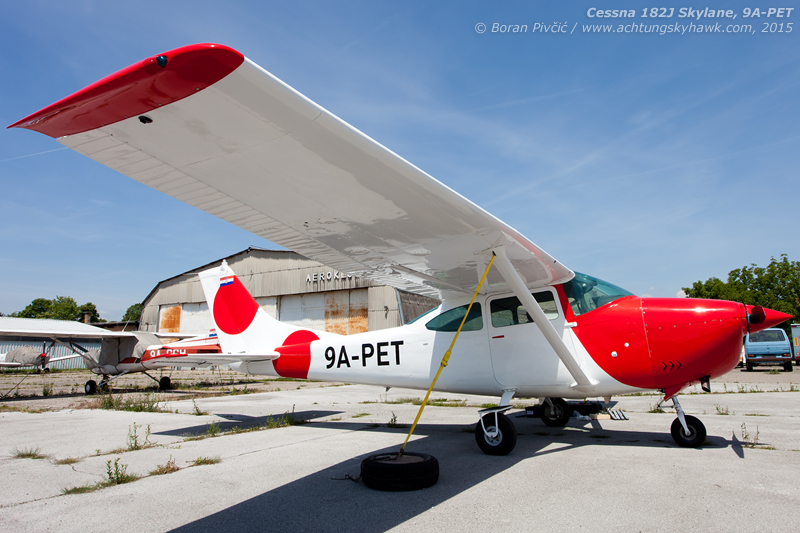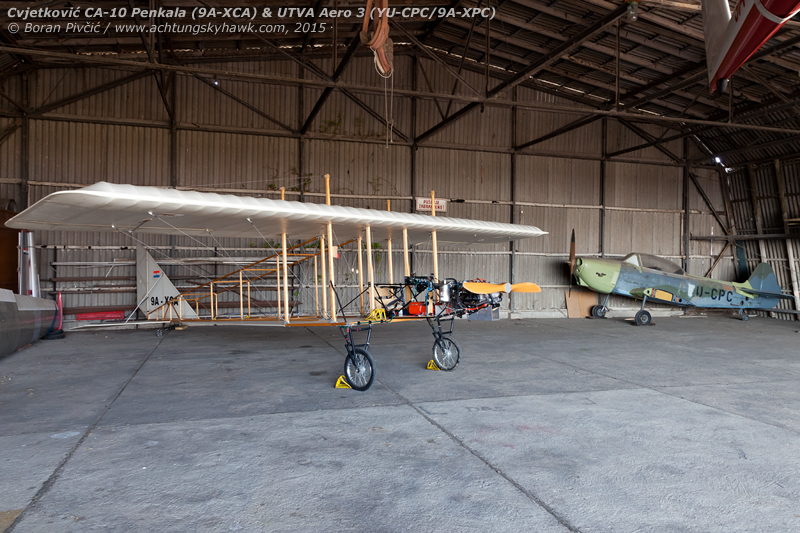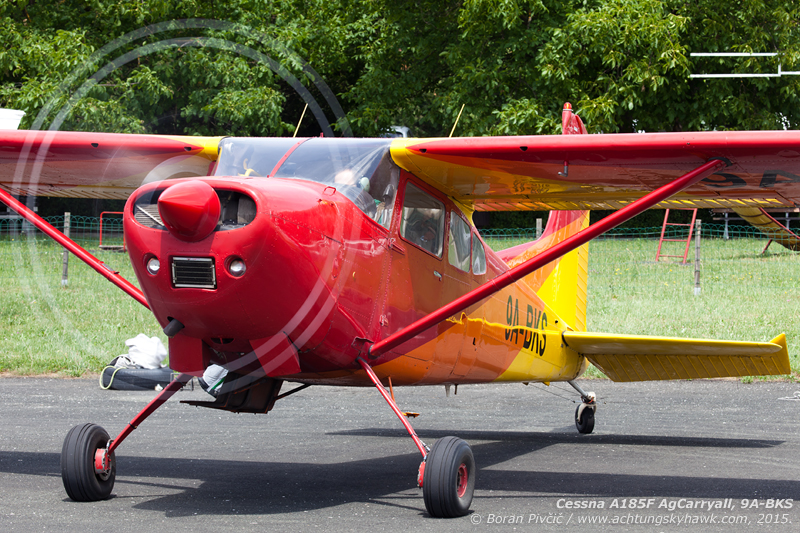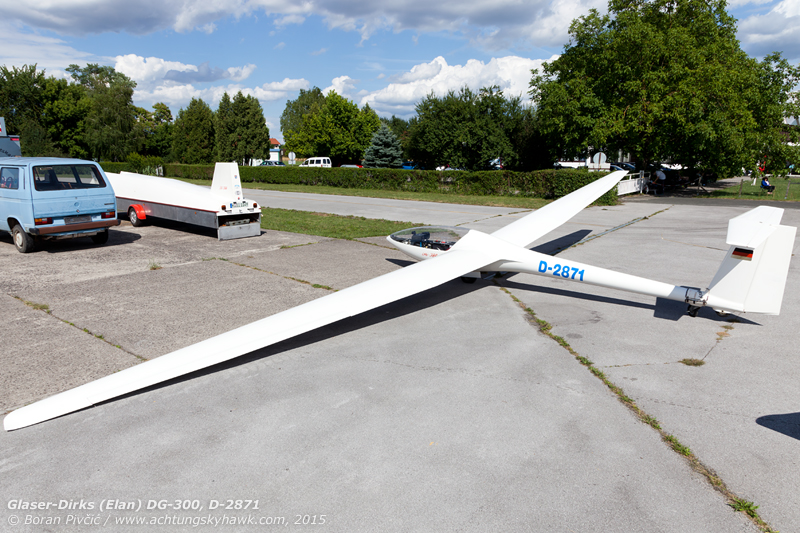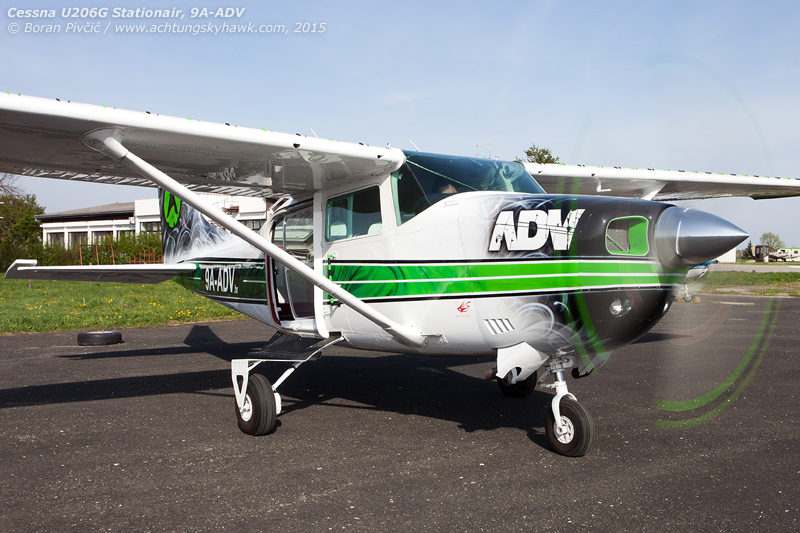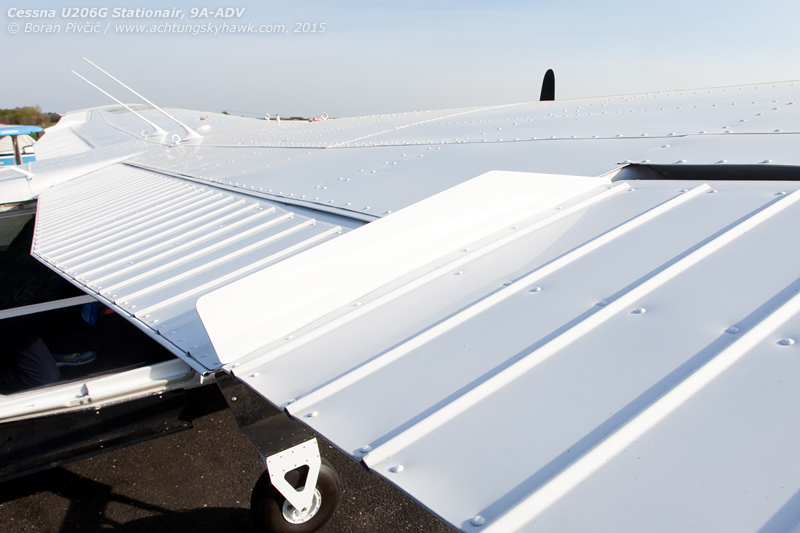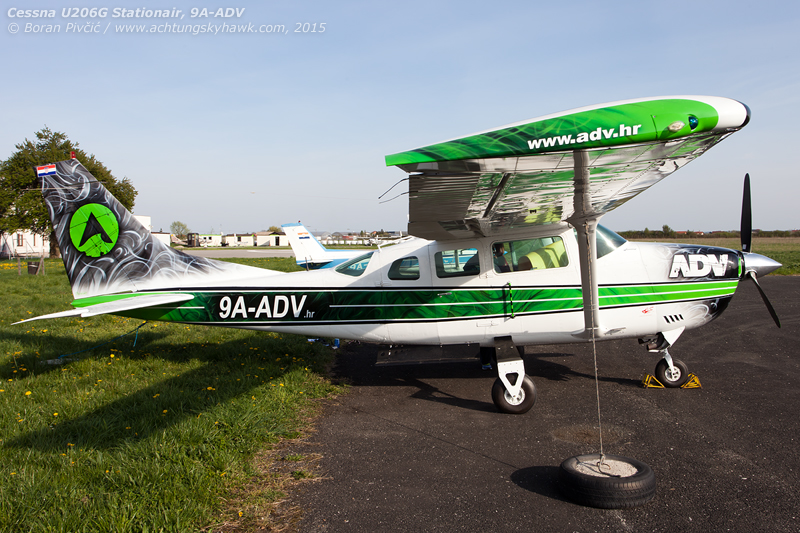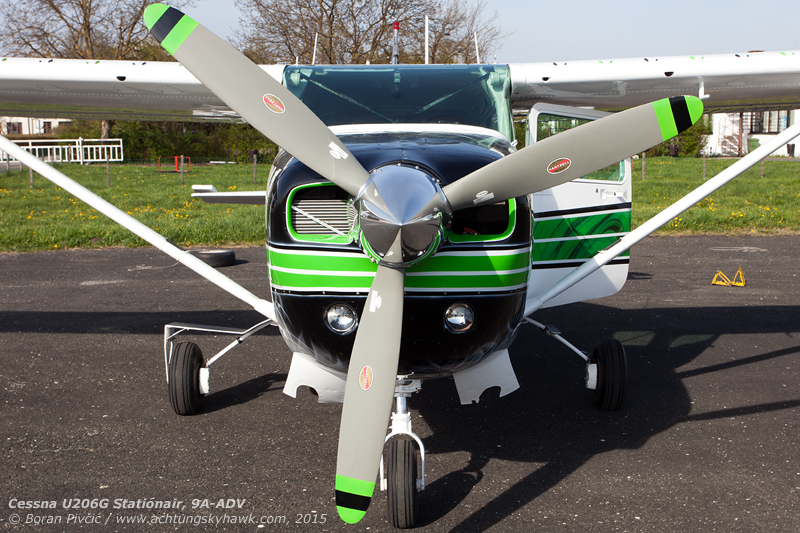By me
All photos me too, copyrighted
Anybody who has ever read anything on this website will know that I have quite a thing for rare, unusual and interesting general aviation aircraft; if anything, that’s kind of Achtung, Skyhawk!‘s whole deal 🤔 . And since I am also a lifelong “mediteranophile”, I have a particular soft spot for Italian, French and Spanish designs, mostly because their whole concept, style and technical solutions always seem to fly right into the face of the accepted Western norm.
So you can imagine that when offered the opportunity to fly an early, first-gen example of one of France’s best-selling piston singles, my interest was very much piqued. But when asked to also ferry it all the way from Spain to its new home in Croatia, my attention was definitely had! 😀
Grandpa runs the marathon
But first, the customary Achtung, Skyhawk! preliminaries. The aircraft in question is a Morane-Saulnier MS.880B Rallye Club, manufactured in 1968 with the serial 1194 – which makes it part of one of the type’s earlier production batches, made just after the company morphed into the more well-known SOCATA in 1966 (though many documents would continue to use the original MS name for some time afterward). Unlike many of its kind, its life so far has been pretty hum-drum, having logged just under 5,800 hours with only four previous owners and two regs, the original OO-CLS and, from 2010 onwards, today’s D-EBKB. Really the only bit of excitement and genuine drama in its life was back in the early 80s, when it suffered a tail strike on landing that required the whole aft fuselage to be replaced.

Our mighty mouse being prepped for its final flight from its now former home. The previous owners had christened it “Virgen de Loreto”, Our Lady of Loreto, which I’m given to believe is the patron of aviation and air forces in Spanish-speaking countries. Given the ease with which we made the entire flight, one could argue she was pulling double overtime!
In its original guise and with its original paint + the old damaged fuselage in the back (photo from Airport Data)
Being a B model, it sports a 100 HP Continental O-200-A four-cylinder engine, the very same unit also found in the Cessna 150; combined with a Maximum Take-Off Mass (MTOM) of 770 kg | 1,700 lbs, on paper this gives it a very similar power-to-weight ratio and performance bracket to the 725 kg | 1,600 lbs late model 150. IRL however, the Rallye’s thicker wing profile and full-span slats do change the equation a bit, for while they make for measurably shorter take-off and landing runs, their extra drag means you do pay the price in the after take-off climb – particularly at the sort of high density altitudes common to continental Spain1. And while you can force the slats to close immediately after lift off in order to clean up the wing, to do so you have to accelerate to approximately 130 km/h | 70 kts (very near the 135 km/h | 73 kts best climb speed), which is not always possible without resorting to level flight, potentially throwing your obstacle clearance out of whack.
Haulage-wise, the standard fuel system (fitted to D-EBKB) is made up of two 52.5 liter | 13.9 USG tanks, which give a total usable fuel of 94 l | 24.8 USG – though there is also an optional long range setup with two 92 l | 24.3 USG tanks for a usable total of 170 | 44.9. With empty masses generally around the 500 kg | 1,100 lbs mark, with full tanks the basic model has a respectable 190 kg | 420 lbs left over for the payload, which today easily accommodates two modern adults with a bit of baggage2.
1 for the most part, the O-200 was considered perfectly adequate for the majority of operations, especially since it combined good fuel economy with reliability and ease of maintenance – all stuff that sounds perfect in marketing materials. However, to cater for the remaining minority that either required more poke or wanted an engine more suitable to their needs, Morane-Saulnier had also offered the:
- MS.881, powered by the homegrown 105 HP Potez 4E engine (in variants 20, 20A and 20B)
- MS.883, powered by the 115 HP Lycoming O-235-C2A
- MS.884, powered by the 125 HP Franklin 4A.235.B3
- MS.885 Super Rallye, using the 145 HP six-cylinder Continental O-300 (versions A, B, C or D), as seen in the early Cessna 172
- MS.886, with the 150 HP Lycoming O-320-E, and the
- MS.887, with the 125 HP Lycoming O-235-F2A
Despite all this variety, most of these were produced in pretty much “token quantity”, with only the 883 and 885 managing to cross 50 examples (77 and 212 respectively if Wikipedia is to be believed)
2 being of 1960s design, the MS.880 was scaled to meet the sizes and masses of the people of the day – hence it being officially classified as a three-seater. And indeed, if you were a 70 kg male with a 60 kg wife and 30 kg kid, you could still take a full 30 kg of baggage, easily enough for a few days away. In 2022 though, the owner and myself – both on opposite sides of the 1.9 meter mark and pushing 90+ kg with our headsets, tablets, cellphones and cameras – were struggling to pack a change of clothes and clean underwear…
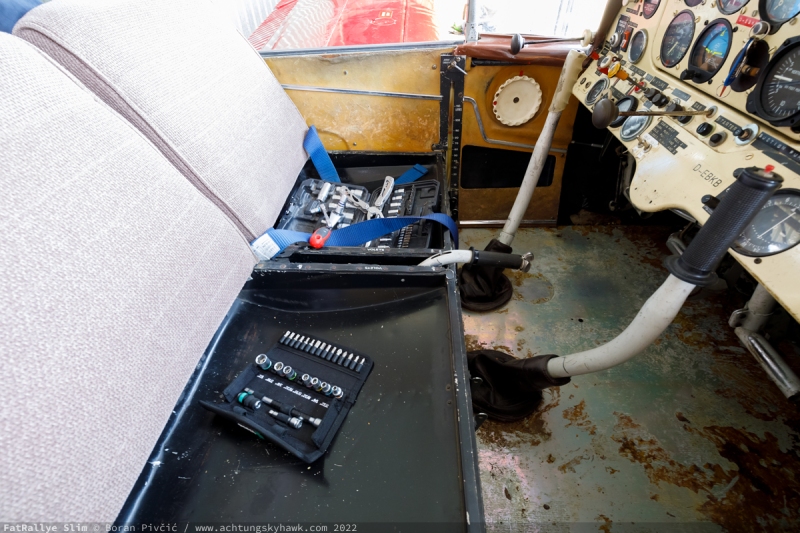
In light of these performance issues, we thought it best to attempt a bit of weight saving before departure. Up front thus went the heavy seat cushions, the carpet (which all on its own weighs some three kilos!) and the vacuum tube NAV/COM 2 radio…
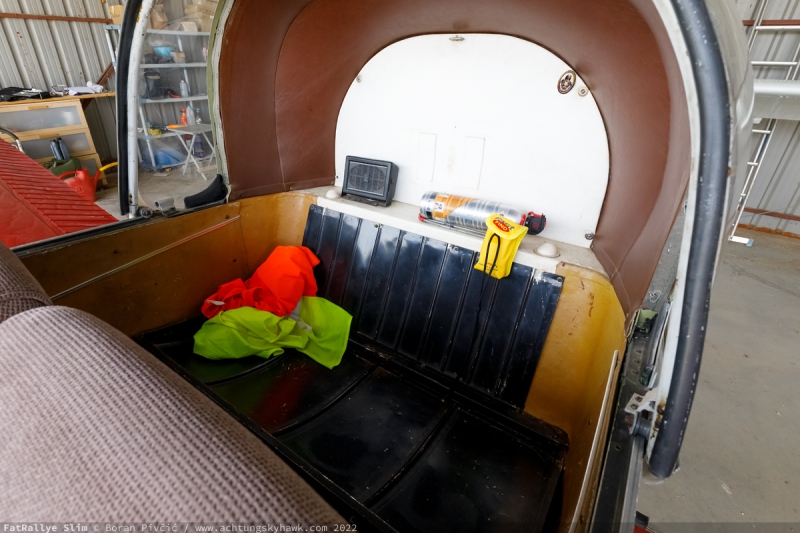
… while out back, we ejected the rear seat upholstery in its entirety, the towbar, cargo net and all but the most essential equipment and tools (and a few quarts of oil). By the time we were finished, we had managed to throw out more than 20 kilos, a solid 4% of D-EBKB’s empty mass and equivalent to a full hour’s worth of fuel
The plane in Spain climbs poorly on the plain
Now time for the flight itself. As often happens whenever I start writing, my original idea of making just a simple “cheap & cheerful” photo story had quickly been thrown out in favor of a far more detailed work that would eventually take me three days to write. Since this was the first time in my 20 full years of flying that I had done a ferry flight of this magnitude, I reasoned that a road map of my mental process during the planning stage might make for a much better read – especially since putting it down in writing would also provide me with a chance to sort out the experience and more thoroughly analyse both my initial preparation and my actual performance (and, of course, show off a couple of my best photos 😀 ).
So, to set the ball rolling, here’s a quick summary of the background to the whole operation. Back in early 2022, a friend from Lučko had told me that his son – a PPL(A) holder w/ helicopter experience – had bought an 880B as a personal time-building machine, and since he lacked the experience to fly it over himself, asked whether I would be willing to do the ferry with him. The aircraft was located at Cassarubios del Monte (LEMT) just to the southwest of Madrid, and would need to be flown to either its ultimate destination of Hvar (LDSH), or the intermediate stop at Lučko (LDZL) – all in all, a respectable great circle distance of 1,750 km | 940 NM. The only “catch” was that we’d have to wait for April at the earliest for the paperwork to be completed and the airplane to undergo regular maintenance in preparation for the flight – which also gave me ample time to both request vacation time well in advance, and wait out the fickle spring weather, while still avoiding the hellish heat of full-on summer.
Having been given free reign to plan the whole thing as I saw fit, I set my airline OCD to 11 and then spent the better part of two weeks exploring various route options and fine tuning ideas until I was satisfied with the end result. While this may seem a bit over-the-top (especially since I was using flight planning software that did all the calculations for me), I was still wary of the fact that I had never done anything like before – and that while I do have a ton of trans-European experience, the vast majority of it is in an airline environment, with five figure power outputs, comprehensive avionics, double & triple redundancy, another experienced crew member and Dispatch and Operations departments to call on. If anything, my airline experience had only served as a reminder of just how complicated planning could become (being on the receiving end of it), and just what can go wrong so easily and in such creative ways.
So, while pulling a few legs on a mobile app did indeed take just a couple of minutes, deciding where to pull them took up considerably more time. The legwork that I needed to do in choosing routes and airport stops was predicated by:
1. aircraft performance: as suggested previously with the 100 HP and thick wing, the 880B relies significantly on the curvature of the Earth to climb at higher altitudes and temperatures. So while the type’s “nearly STOL” credentials were not limiting in terms of runway length, they were a very real factor in clearing close-in obstacles and terrain, of which there are many along most of the Mediterranean coast. Compounding the problem was that with the two of us, our essential baggage and full (or nearly full) tanks, we’d be constantly operating at MTOM, further degrading our all-round performance and leaving us very little leeway. Thus, choosing airports for stopovers became first and foremost a question of being able to actually get in and out without undue sweating and swearing, and always being able to have Plans B through Z in case something goes to pot. For this reason, I focused exclusively on paved airstrips, where I could be reasonably sure that the surface held few surprises, and that we’d encounter less rolling resistance, fewer slopes and less chance of ending up stuck due to unfavorable weather
2. fuel and fuel consumption: the first stumbling block with this one was getting an accurate fuel burn figure; D-EBKB has no flowmeter, and I have had enough first-hand experience to take figures in the Pilot Operating Handbook with a grain of salt – especially given the airplane’s advanced age. The only thing I had to go on really was the previous owner, who from his own experience gave a figure of 26 l/block hour | 6.9 GPH at 2,500 RPM, giving around 140 km/h | 76 kts indicated in the cruise (which is a pretty high burn for that speed in O-200 terms). With 94 liters of usable fuel, he considered the realistic endurance to be around 3 hours 20 minutes, roughly on par with that of the Cessna 150.
However, while useful, these figures could also be a pretty sharp double-edged sword. The majority of D-EBKB’s previous flying had been done in highland Spain, which implies high density altitudes, prolonged climbing, and frequent operation at higher power settings – all of which have considerable influence on fuel burn and are not representative of all the conditions we’d be flying through on our way to Croatia. Then there’s also the previous owner’s flying style: how did he climb? how did he lean? how much weight did he carry? what altitudes did he cruise at? what were the average sector lengths? how would my own flying differ? and so on.
Unfortunately, since I had only partial answers to the above (there was a language barrier involved), I had to work with what was available – and then overlay that with a thick layer of additional protection. In combination with my desire to have a flexible and adaptable plan, the somewhat pessimistic fuel burn figure, and the small size of the Rallye’s tanks, this cushion had measurably reduced our possible flight times, adding yet more complexity to the planning. As on any of my own personal flights, my fuel plan was thus generally conservative, and on top of the required 45 minute reserve implied:
- fuel to reach a realistically distant and realistically usable alternate that satisfied the same criteria as our destination (and not just the first sufficiently long stretch of runway that could take a Rallye)
- contingency fuel equal to 15% of our trip fuel, as protection against higher-than-standard fuel burn, sub-optimal leaning, and my poor math & ham-fisted flying
- and 20-30 minutes of additional fuel to cover issues like possible deviations off track, altitude changes (since we would mostly be sticking to 1,000 ft above ground), weather avoidance, stronger winds, and the possibility of holding at busier regional airports
What remained thus became the trip fuel. The upshot is that we ended up with possible flight times of up to 1 hour 40 minutes, which at 140 km/h make for approximately 250 km | 135 NM in one go. The issue here is that in parts of Spain (northeast) and Italy (northwest) there are not many airports within the distance that can readily fulfill our criteria, which naturally had a lot of bearing on both the choice of routes and the maximum flight time that we were willing to go to in order to avoid undue in-flight complications.
To illustrate just what sort of rabbit hole this can turn into, a fuel check and brief analysis after each flight revealed that our actual block consumption at said 2,500 RPM ranged from as much as 29 l/h | 7.7 GPH on the high plains down to as little as 21 l/h | 5.5 GPH along the coast, illustrating that a) a “one size fits all” figure is bound to be crap by default, and b) that with growing experience of the aircraft, careful leaning and as smooth a throttle operation as was possible in the conditions, we had managed to stretch our endurance by up to 30 minutes. Indeed, this better-than-planned fuel flow came in handy after we started encountering stronger headwinds over Italy, since we could now punch the RPM up to 2,650 and still meet our originally planned endurance figure despite a 31 l/h | 8.2 GPH fuel flow
3. aircraft handling: to expand on the previous paragraph, I also had to take into account my unfamiliarity with the Rallye (save for the couple of hours I’d logged on the bigger 150 HP MS.892 several years ago). Given the type’s pussycat behavior and the robustness and tolerances inherent to its design, this was not so much an issue of safety as it was of efficiency; any planning thus had to take into account that I’d need some time and at least a couple of legs before I even started hitting the performance figures in the POH, let alone getting the most out of the aircraft
4. weather: while the meteorological situation on a regional scale was important, so too were local conditions at and around our stopover airports, as well as at specific points en-route. For the first fifth of the trip, we’d be operating out of continental airports at 2,000+ ft above sea level, which – due to the absence of the sea’s stabilizing effect – experience considerable daily temperature variations. On the day before our departure, D-EBKB’s former home thus saw a temperature low of just 5° C at dawn… and a high of 35° C at 3 PM. This variation in density altitude and consequently aircraft performance would be keenly felt even with the 10,000 HP of the Q400, let alone the 100 of the Rallye. Thus, planning also hinged on using the morning chill as much as possible, and avoiding high terrain and obstacles during the high heat of noon (at least until we made it to the coast). Later on in the trip, the southern foothills of the Alps required their own approach – especially for their tendency to boil over with enthusiastic vertical cloud development – as did the fast-changing weather of the Genova Low. Finally, we’d have to cross the Velebit mountain range in Croatia, which has had a depressing number of aircraft carcasses litter its sides over the years – though here at least I could call on some of my own experiences of flying by over in aircraft with similar power-to-weight ratios
5. airport services: another issue that had to be balanced was the minimum level of airport service necessary, and avoiding complicated handling procedures common to larger airports (not to mention their traffic flows). While it may seem a stretch to claim that the Rallye needs some “minimum level of service”, being on a ferry flight and unfamiliar with most of the areas we’d be flying over, I had to take into account the possibility of change of plans due to weather, mechanical failures, in-flight re-planning, airspace closures and so on. So, the airports and airfields that I chose – destinations AND alternates – had to have:
- a readily and commercially available supply of Avgas (since many smaller fields have fuel solely for their own purposes)
- a flying club, airport operator or handling agent that could render logistical assistance
- a maintenance shop with at least basic tools
- acceptable accommodation nearby
- and, for end-of-day legs, at least basic runway lighting
The availability of these services would have to be checked and confirmed by email and/or phone with each airport in turn, which alone had taken up almost two days. Further complicating things was that many regional airports in Spain and France (which are quite practical and very convenient) require prior permission or advance notice, which is doubly complicated when you aim to have a flexible plan that allows considerable space for improvisation should there be a delay or problem. The one thing at least that we didn’t have to worry about 95% of the time were customs and immigration, since all but the final leg were within the Schengen Area, and both of us have EU passports
6. rules, regs & local knowledge: passing as we were through unfamiliar territory, no detailed planning was practical until I had familiarized myself with the Aeronautical Information Publications (AIP) of Spain, France and Italy. While only a small fraction of that complicated mass of documents actually concerned us (general rules, VFR rules, VFR routes, airspace structure and such), they were still full of blind bends and loopholes that all had to be navigated in order to assure a stress-free trip.
Thankfully, I had much outside experience to call on here, starting with D-EBKB’s former owner (language barrier notwithstanding)… then Lukasz from Poland, who now actually lives in Spain, has had an 880B before and whose MS.892 I had flown and wrote about… and a friend from Lučko who flew his TB-20 and DA-42 pretty much all over Europe several times over. Such a huge mass of information was very welcome and gratefully received – but it still took some time to badger all of them with my stream of (occasionally stupid) questions and then process the results. Another good resource were various EU GA websites, as well as pilot reports within the flight planning app, which were often more revealing than all the docs in the AIP put together…
7. airspace configuration: another expansion of a previous point, and particularly applicable to southern France. Due to the large number of busy international airports and large military bases along the coast – Perpignan, Montpellier, Marseille, Nice, Cannes, Istres, Hyères – VFR transit routes over there are pretty restrictive both in lateral and vertical terms. To avoid causing a mess with commercial traffic on approach and departure, these routes limit light aircraft to between 500 and 1,000 ft above ground/water, which had to figure in available glide range and even the possibility of ditching and rescue
8. aircraft and system reliability: the big elephant in the room. “54 years old”, “first generation” and “trans-Mediterranean” may all sound full-on Achtung, Skyhawk! – but when you’re not typing that from a comfy chair and your ass is instead directly on the line, they take on a whole new kind of weight. Thankfully, much peace of mind was assured by the airplane’s excellent mechanical state (despite its tattered visual appearance), complete insight into its entire maintenance and damage history, a number of test flights prior to departure – and the new owner’s maintenance experience, which gave him a far more informed opinion than mine could ever hope to be. Props also go to him for indulging me in tearing apart the nose to check on the tautness of the throttle and mixture cables, something I’m quite touchy about given my past experiences on the 150…
In spite of these assurances, any planning had to take into account that the engine may go belly up at any moment – especially if it’s a bad one, as the patron saint of aviation, Murphy, is always teaching us. On overland flights, this included familiarizing myself with the terrain en-route (as much as I could online and without actually seeing it with my own eyes), and in flight keeping just a tiny bit closer to any formal airstrips where available – even if they’re intended for microlights only, since a short runway is better than no runway at all. Avoiding any extended overwater flight was as obvious as said water being wet (heh), even though it could not always be helped due to the aforementioned route restrictions. Lastly, the good thing is that both the O-200 and the original Rallye are so simple and robust that there’s really nothing on them delicate or fussy enough to break easily, which did go a long way to reducing stress levels in the cockpit.
The same approach also applied to the potential for on-board equipment failure, particularly the instruments and/or radios. To that end, we took along multiple mobile devices all fitted with the same flight planning software, as well as apps that use the unit’s GPS and internal gyros to simulate the Basic T should we lose any of the few primary instruments we had. Rounding all of them up was a powerful hand-held 8.33 MHz radio, as well as a set of torches, spare fuses and USB chargers to keep all of that tech fed
9. costs: ironically, a factor that made the whole operation into the non issue it turned out to be, and was a significant factor in my decision to take this flight on. As well as being given complete control over the flying side of the whole thing, I was also given pretty much a free hand financially, since the brief was “get yourselves home safely” and “price cutting doesn’t mean a damn thing if you’re dead”. However, while the financial considerations did thus drop to the bottom of the list of priorities, it would still be foolish and irresponsible of me to behave like a drunken millionaire, especially with current gas prices and inflation. Thus if I had a choice of two airports that offered the same level of handling and had the same (or very nearly the same) risks and benefits, I would tend to go for the cheaper option, particularly since I could usually arrange in advance to have available (and be charged for) just the services we actually needed. While this may sound highly specific, it was actually a common occurrence along the coast of France, with so many high quality GA airports on offer in a small area that you were spoiled for choice like a kid in a candy store…
ADDENDUM – 10. physiological factors: a frequently overlooked, but very pertinent, set of issues that should feature in any proper long-range planning – and which I had ironically overlooked (heh) when initially publishing this work. Yes, one of said issues was indeed coming to terms with the depressingly limited endurance of my bladder… but overall, they go so much further than that. Being a short-haul turboprop driver, I’ve had many an opportunity to experience first-hand just how much:
- cockpit temperatures
- vibration
- noise
- sitting position & seat quality
- restricting elbow/leg/head room
- unergonomic controls
- exposure to sunlight
- headphones + accessories
and the like have an influence on one’s performance during flight. The problem are not so much their individual or combined magnitudes – but the insidious effects of prolonged exposure to them that slowly, almost imperceptibly, erode your concentration, reaction time and judgement, while at the same time contributing to an increase in tiredness, irritability, forgetfulness, risk taking and the overall chances of royally screwing things up.
Like the Q400, the Rallye ticks pretty much all of the boxes mentioned. And while nearly 5,000 hours’ worth of exposure to them had definitely steeled me for the trip, these were still issues to be very wary of, and which had to factor prominently in both the maximum flight time and maximum number of legs we’d be willing to do each day (particularly since D-EBKB’s new owner had not gone through the same Regional Turboprop Meat Grinder, and would be expected to take the strain significantly worse than I). Since we were not pressed for time at any point during the trip, and had beautiful weather forecast for the entire week, I decided to adopt a similar approach to some airline scheduling departments, and start out strong and hard-hitting – but then progressively reduce the load and increase rest times as accumulated fatigue started to set in. As an upshot, Day 1 would thus see us do five legs for a total block time of seven hours – while Day 3 would whittle that down to just two legs and three block hours. Combined with an early arrival on Day 2 (6 PM) and late departure (11 AM), the latter had had significant beneficiary influence on our level of alertness and vigilance, especially important since we were a) due to cross the aforementioned Velebit mountain range on a windy day… and b) were within spitting distance of home and had to be on extra lookout for any “get-there-itis”
The Madrid-Zagreb Rallye
With the (not inconsiderable!) list of requirements finally reconciled, the end route ended up looking almost like a drunkard had planned it after a heavy binge session. The complete itinerary thus included:
DAY 1: Cassarubios del Monte (LEMT) •• Ocaña (LEOC) •• Requena (LERE) •• Reus (LERS) •• Girona - Costa Brava (LEGE) •• Béziers - Cap d'Agde (LFMU) DAY 2: Béziers •• Le Castellet (LFMQ) •• Albenga - Riviera (LIMG) •• Cremona - Migliaro (LILR) •• Padova - Gino Allegri (LIPU) DAY 3: Padova •• Portorož - Sečovlje (LJPZ) •• Lučko (LDZL)
And for how it actually turned out, here to tell the story are the best bits: the photos! 😀
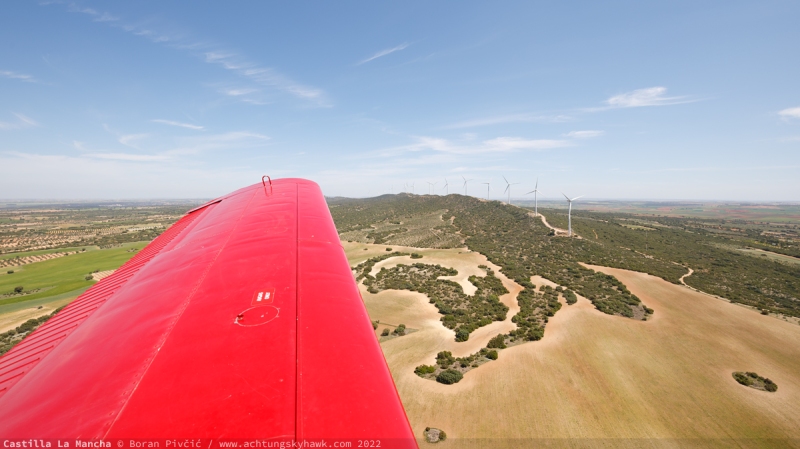
Wind turbines, rolling hills and endless sun-burnt fields… the wonderful Spanish high plains in a nutshell. Their gentle nature, moderate elevations and ample space to land in case of engine trouble were the primary reasons for taking the longer southeastern route toward Valencia and then up the coast, rather than cutting directly northeast via Zaragoza and crossing Aragon’s Sistema Ibérico mountain chain
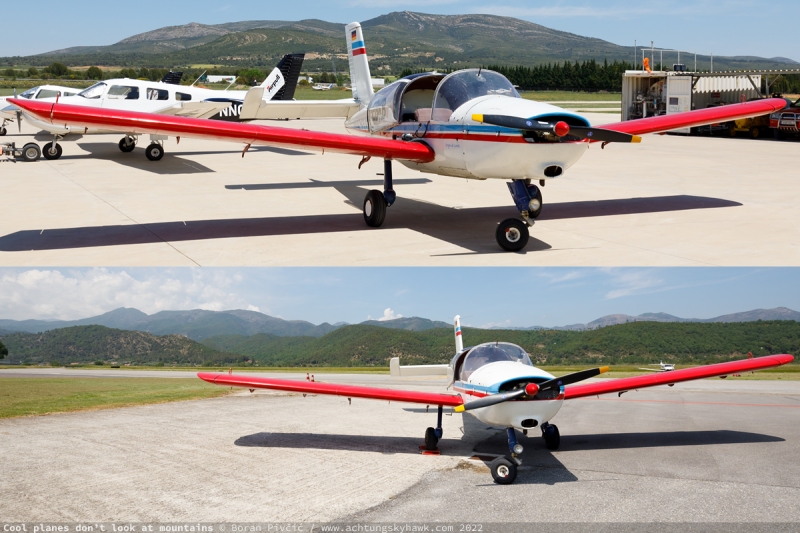
The “Looking Cool In Front Of Mountains” Starter Pack, first at Requena’s 2,340 ft and then Albenga’s 149 ft. While I do love both poses, they were actually borne out of necessity rather than aesthetics. D-EBKB has the type’s original (and temperamental) fuel system, in which both tanks are permanently interconnected; the fuel level between them thus takes some time to equalize, and if you fill both to full in quick succession on any form of sideways slope, fuel with soon start to vent through the underwing relief valves. So once refueling was done, we had to quickly reorient the airplane into a position where the wings could be as level as possible until the fuel settled – often with good visual results
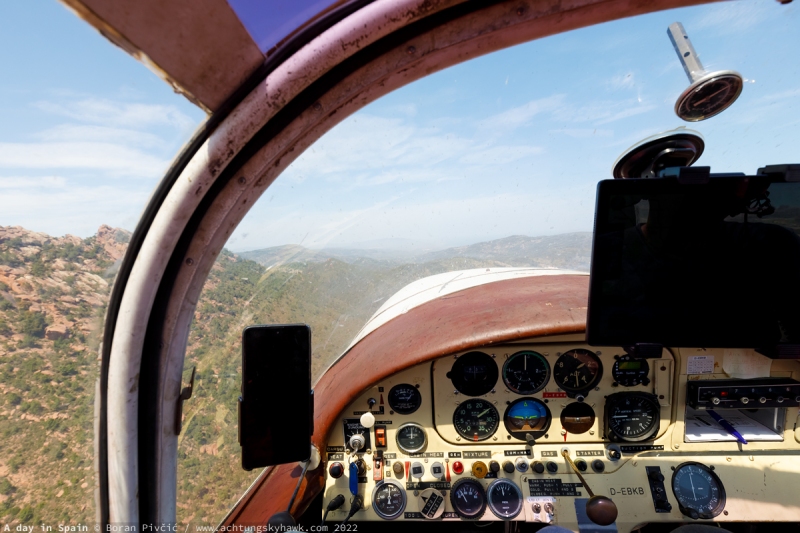
High sun, scorched hills and a view full of navigation devices… perfectly sums up Day 1 in Spain! Though we were worried the exposure to direct sunlight through the transparent canopy would have a negative effect on the tablet (particularly in terms of heat), all devices remained cool and trouble-free throughout the trip, no doubt due to a helping breeze from the overhead ventilation grille

An off-beat airplane, a quirky panel, a calming sunset – and below us the beautiful Gulf of Lion (which we did not actually cross, but turned out to merely for the photo opportunity). The slats and this cockpit setup are probably my two favorite things about the early 880s; they just give them so much character and style. The visibility is epic… the whole cabin is airy and comfy… the instruments are a fascinating Anglo-French-US mix… the aux fuel pump switch and generator light look like Sean Connery’s Bond is about to pop up and use them… and most the levers have no sense whatsoever, since you push the throttle and mix to go – but pull the electrical master and cabin heat/vent knobs for them to do their thing
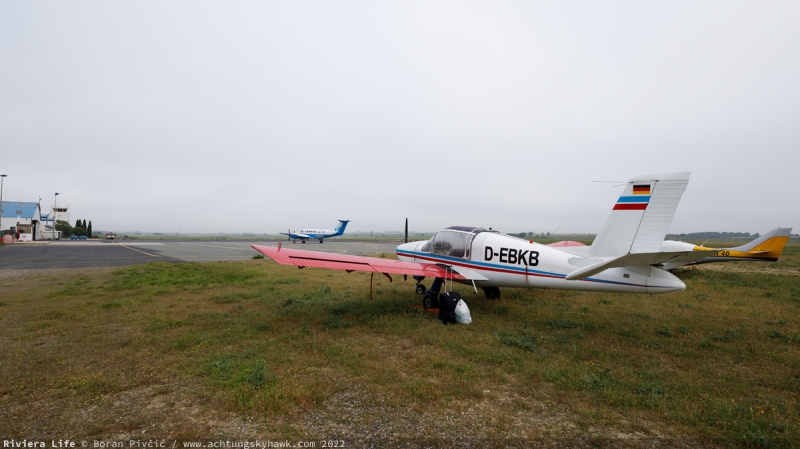
A suitcase in front of a personal airplane on a foggy dawn at a chic GA airport on the French Riviera… I feel like cut-price version of the Côte d’Azur jet set

Skirting the edge of the morning sea fog off the coast of Marseille. Like summer fog in Zagreb (and unlike the week-long blanket in winter), this one was extremely localized and cleared up within 30 minutes; indeed, visibility on the left was such that we almost saw Paris…
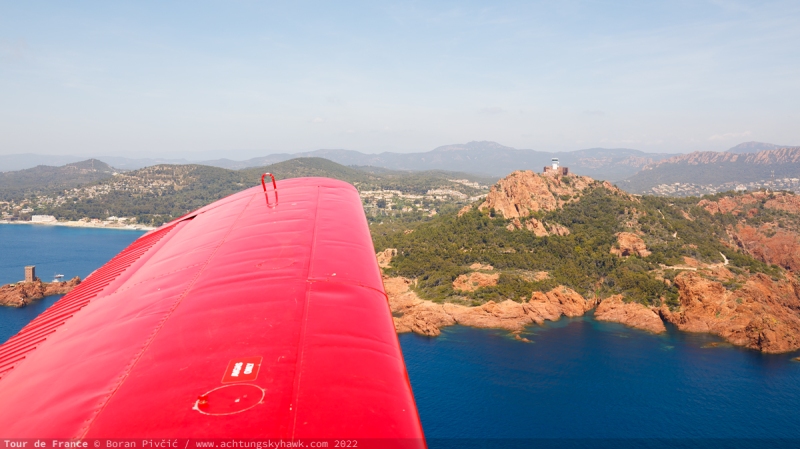
Being stuck at 500 ft all the way from Saint-Tropez to the Italian border meant we could at least enjoy the sights significantly closer up than usual… in this case the Cap du Dramont just off the picturesque town of Saint-Raphaël. Riviera cruising the proper way!

The Fueling Twin-Pak, Le Castellet at top & Cremona below. One of my more subtle planning failures was underestimating the time needed to refuel; no, not the actual process itself, but sorting out the bills afterwards. Same thing for landing fees; while not complicated in any way, it does take up more time than I’d expected, particularly since we were first-time visitors at all airfields en-route, and had to fill in extra paperwork as a result. Thus the 30 minutes that I’d planned for each stop at smaller airfields quickly turned into 45-60 (and more), except at Girona where we were all done in just 25…
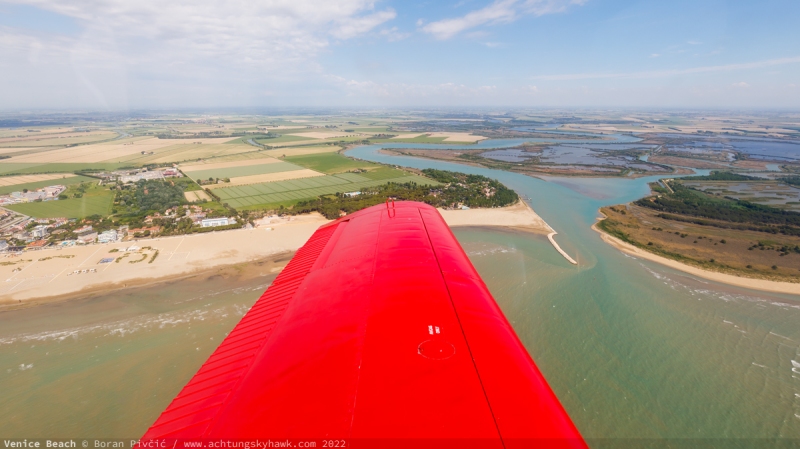
Cruising by Venice Beach… no, not the one in LA, but the one near actual Venice. The abundance of sandy beaches – some miles long – that offered ample place to land in case of engine problems meant that following the coastline at the top of the Adriatic was a complete no-brainer, particularly since it added just 10 minutes to our flight time over a direct hop across the sea
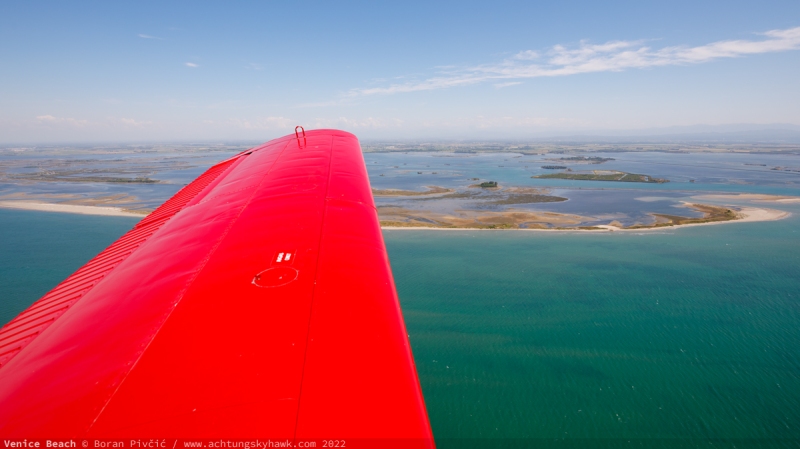
Day 3 of 3, Leg 10 of 11, clear skies all the way, and familiar territory ahead… with as calming scenery as this, you can finally start to appreciate the magnitude of the whole trip, especially given our airplane’s sedate cruising pace and leisurely attitude to climbing

And finally (almost) home, parked at Lučko next to one of my daily drivers (sporting a brand new lick of paint now), just one minute after our planned arrival time. As mentioned previously, D-EBKB’s ultimate home will be Hvar Airfield on the island of the same name, but it will initially spend some time here at Lučko (where I had quite a bit of STOL fun with it in the meantime)
And finally, a little timelapse vid of one of the most scenic approaches of the trip (in pretty strong competition): the visual for RWY 09 at Albenga (sorry for the poor quality, the canopy is quite old + this was the only place I could put the camera without it rebooting due to vibration):
Totting up + lessons learned
So, when all was said and done, the end stats looked like this:
- total block time: 17 hours 10 minutes
- total time en-route: 75 hours 20 minutes | three calendar days
- number of legs: 11
- total distance covered: ~2,200 km | ~1,190 NM
- average cruise ground speed: ~135 km/h | ~73 kts
- recorded ground speed extremes: 165 km/h | 89 kts •• 75 km/h | 40 kts
- elevation extremes: Ocaña (LEOC) 2,405 ft •• Portorož (LJPZ) 7 ft
- total fuel used: ~460 l | ~122 USG (with RPM settings from 2,500 to 2,650 RPM)
However, much more important than any of these were the lessons I’d learned along the way. Since this was, as oft mentioned, the first time I’ve ever done a flight like this, it was inevitable that I’d make some missteps in the process, which – provided I lived to tell the tale – would allow me to both learn about myself and my (lack of) skills, as well as make for an interesting analysis of where I did good or bad.
The good is pretty obvious: we made it safely to where we needed to be. But, more than that, we had no significant operational issues along the way; we arrived at Lučko exactly to plan; we had no mechanical problems whatsoever (except a transponder that would overheat after six hours of operation); made no airspace infringements or AIP violations; and were more-or-less in our expected budget range. The entire trip was so smooth in fact that the biggest problems on our plate were cockpit temperatures, uncomfortable seats – and the nagging issue of our climb performance always fermenting somewhere in the subconscious. Indeed, we had commented more than once that we’d managed to cross half the Mediterranean with less fuss, delays and frustration than it sometimes takes to rent a Cessna 172 on a busy day and make a 30 minute panoramic flight (and that’s not an overstatement!).
Not only that, but the scale of what we’d done (in light of the performance limitations of the aircraft) has led to much professional maturing on my part, both by validation of the quality of my planning, and the realization of the amount of effort and foresight necessary to do it all by yourself… not to mention the sobering number of ways it could have all gone very wrong.
And now, for the more interesting part: the bad. While the amount of planning I’d invested was indeed the key to our carefree success, it would be foolish – and quite dangerous – to just pat myself on the back and leave it at that. As I mull over the whole thing a week later, I can identify several issues that would require more effort than I put into them, and that I’d definitely do differently if given the chance again:
- trust your charts – but keep your options securely open: since even a cursory glance at the 880B’s performance tables had foretold the difficulties of operating at high masses and high temperatures, I took extra care to familiarize myself with both the terrain en-route, and around each stopover airport. Despite having studied numerous airport charts and satellite images, I was surprised more than once to realize just how… hmm… “colorful” the actual terrain really was, and just how misleading 2D (and even basic 3D) depictions could be. Area diagrams, VFR charts and Google Earth also did not accurately depict many obstacles further out along the departure path (such as trees, houses or power lines), which made for a few very lively take-offs up in the mountains, and considerable improvisation and re-planning right on the spot. So, while all of these tools are indispensable and definitely the basis of all planning, they are not the by-all-and-end-all – and should be looked at with a more critical eye and a full suite of backup plans and options
- what goes up must come down: the vast open plains of Spain, clear skies and the rapid increase in temperature during the day are a sure guarantee of strong thermal activity, which can be a useful tool in aircraft with marginal performance; indeed, back in the times of skydive ops, it was not unusual to hitch a ride in them when climbing up to 10,000+ feet, since at those altitudes even a stripped out Cessna 182 could eek out just a paltry 200 feet per minute in the climb. However, since I was unfamiliar with the area’s thermal potential (and lacked the gliding experience to be able to judge it with what I would consider to be a sufficient level of precision), I decided to disregard them as an active factor and treat them as a hidden benefit. Unfortunately, despite some motorglider experience, I had failed to take into account that updrafts tend to be accompanied by downdrafts, which should then be classified as a “hidden danger”. This too made for some interesting initial climbing in Spain; and while I pretty quickly added their potential to the mix, it was still a fail on my part not to have considered them a problem right from the outset
- optimistic ground stop planning: something I’d already touched upon in one of the photos above. While my plan included a lot of space for improvisation and soaking up delays, I was still working under the (misguided) assumption that ground handling would be a relatively smooth affair as it is in the airlines. And even though we had hit our 30 minute target a number of times, there were still several airports where we went significantly over the one hour mark. This was not so much of a problem on the scale of the entire ferry; rather, the issue was in reaching our overnight stop, where we had already booked parking space in advance to keep costs down. Case in point was the last leg of Day 1 (Girona-Béziers), where we made it in with just 15 minutes to spare on the ground service operator’s clock. And while all that would have happened had we scrubbed that leg and stayed the night in Girona was a hefty parking fee, more realistic planning could have avoided by a bigger margin a significant increase in costs without any compromise in safety or the overall timing of the flight
- there’s no I in team: a point that particularly smarts given my airline background and its heavy emphasis on Crew Resource Management. The issue that bugs me here is not interpersonal or character-based; quite the opposite in fact, the trip was pretty much like a “boys’ night out”, but with airplanes. The problem lay in my own inconsistency and lack of delegation. When we started the trip, I insisted we do approach briefings, something ported over from the big cockpit and intended to keep both of us in the loop in a critical phase of flight. In this briefing, I would go over the most pertinent issues facing us at our destination – terrain, aircraft performance, runway characteristics, maneuvering areas, expected threats, … – with the purpose of giving the owner a clear idea of what my game plan was, getting his input, and helping him help me by assisting with traffic observation, frequency monitoring, navigation setup and so on. And that worked well… until we stopped doing them halfway into the trip. At first, the reason was simply us becoming more in sync as time went on, and starting to discuss such matters already en-route (albeit in a less structured manner); but later, it also became an issue of tiredness and a drop in novelty as we approached familiar territory (NE Italy, where I had flown a lot). The good thing at least is that the 880B’s asthmatic performance meant we never skipped a thorough performance and obstacle analysis before each flight, and were quite fastidious in agreeing to a suitable strategy for the after take-off climb. The other issue was the distribution of tasks between us. While I certainly did not do everything on my own like I’m a one-man-band – and the owner did sterling work on the ground, particularly handling and airport services – with hindsight I do note that I did do most of the in-flight stuff myself, despite having relied on the owner’s excellent ear for chatter on the radio. My core motivation at the time had been to both avoid breaking up my own single-engine mental flow as I grew more tired, and to avoid piling too much of a load on the owner, for whom this trip was a good deal more mentally exhausting than for me. However, I later realized this was counterproductive on a number of levels, since I had another person on board ready and willing to help (also point I went on about before we set off), and we were really never in the sort of conditions where his lack of flying experience would be a hindrance. If anything, a trip of this scale was pretty much a once-in-a-lifetime opportunity to gain experience you simply could not get in normal in-country flying, which would have been quite the useful educational tool had I used it properly
- trusting mythology: this point has more to do with pre-departure aircraft familiarization than with actual planning, but is still a very important one to make. Having never flown an 880 before, I naturally did a few intro flights with the previous owner, who had had the aircraft for 10+ years, crossed a significant chunk of Western Europe with it, and was well versed in the particularities of operating both out of Cassarubios and Spain in general. And while his input after 35 years of flying was indeed very welcome and useful, I did feel that there were some elements of his handling of the 880 that fell into the category “do it like this, since we’ve always done it like that” – i.e. myths and half-truths passed down from generation to generation without analyzing in depth WHY it is done like that. Case in point were high weight take-offs from short runways, which flew into the face of many time-tested STOL practices – and were later, through experimentation on my part, proven to be at least partially false. My own fault here was taking the previous owner’s experience for granted – given he’s been flying for almost as long as I exist – without insisting I nevertheless try it my own way in controlled conditions and see if my ideas made more sense
Back to the world of grownups
And finally, a well-needed dose of realism and perspective. While everything said so far sounds fine and dandy - and the trip was indeed a "working adventure" that every pilot should try at least one - it turned out that way solely for one overarching reason: the financial and operational latitude that I had been given. Without a set price target (just a general expected bracket and no obligation to stick to it in the interests of safety), I could plan as conservatively as I felt necessary, and put professional best practices at the forefront.
Had I been on a low grade commercial contract like some professional ferry pilots are, things could have been far less rosy, and chances are that my operational freedom would have been severely restricted. In such a case, it would have been entirely possible that I'd be forced by circumstance into cutting corners and pushing beyond my comfort zone, which would have both made planning far more difficult - and made the whole ferry itself a good deal more stressful, with a bigger potential for making a right old mess of it
Sources:
- EASA – MS.880 family Type Certificate Data Sheet (PDF)
Changelog:
- 1 JUN 2022: added “Physiological Factors” to planning stage

